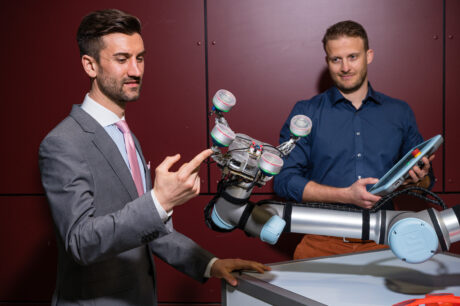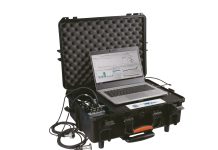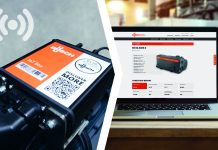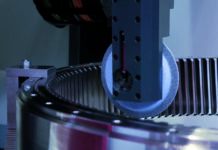Artificial muscles help robot vacuum manipulators get a grip. The robot grippers designed by Professor Stefan Seelecke and his team at Saarland University can grip and manipulate objects with complex geometries. The system can adapt almost instantaneously to changes in form, switching seamlessly between differently shaped parts. The articulated gripper is driven electrically, is lightweight and accelerates rapidly and is even able to tell whether it is holding the object securely enough. The ultrafine nickel-titanium wires that control the motion of the four fingers of the prototype can rapidly generate and release a powerful vacuum via suction cups located on the fingertips of the artificial hand.
In today’s automotive assembly lines, industrial robots manipulating and positioning heavy car body parts are an integral part of the vehicle assembly process. But the gripper systems that these robotic arms are equipped with are often not particularly adaptable. Problems can often arise when the robotic gripper has to switch to handling an object of a different shape, such as trying to take hold of a door panel of a saloon car after just having manipulated the door of an estate model. Flexibility is not a core feature in these conventional systems. If the new door has an opening just where the gripper wants to hold onto the panel, another robot will need to take over or things get complicated as the original robot will need to be retooled and reprogrammed.

«At the present time, robot end effectors – the technical term for the grippers – can only monotonously grasp the same object over and over again, particularly when the assembly process involves handling flat or slightly cambered parts, such as metal or glass sheets,» explains Professor Stefan Seelecke.
A significant step forward
Thanks to a novel development by his research team at the Intelligent Material Systems Lab at Saarland University and at the Center for Mechatronics and Automation Technology in Saarbrücken (ZeMA), these robots may be able to perform significantly more varied operations in future. The technology that the researchers have developed has the potential to improve the adaptability of end effectors, so that they can either be rapidly reprogrammed to accommodate a new workpiece without needing to interrupt the assembly operation, or that they are able to perform these readjustments
themselves using machine learning algorithms. «This kind of adaptable gripper and manipulator system can help to make production and assembly operations much more flexible, especially when you consider the fact that our system does not require any heavy machinery or any electric or pneumatic drives. All it needs is an electric power source,» says Stefan Seelecke.
Seelecke’s team presents a prototype that is a significant step towards realizing this manufacturing goal. The prototype system is itself the result of numerous research projects and doctoral theses. The overall system features a number of ingenious novel developments in the field of robotics, including an articulated end effector that uses artificial muscles to enable the four fingers to move in any direction. Just like a human hand, the robotic manipulator can adapt itself to accommodate differently shaped objects and can therefore avoid, for example, the holes in the door panel of a different model of car. «Our system is therefore not limited to parts with the same geometry,» says Paul Motzki, a graduate engineer who helped develop the system during his doctoral research work. Another feature of the Saarbrücken prototype – and one where it goes one better than the human hand – is that it has vacuum pads at its fingertips, which means that anything the gripper gets its fingers on is going to be held extremely securely.

Bundles of shape-memory ultrathin wires
The artificial muscle fibres that control the motion of the arms, fingers and suction cups are composed of bundles of shape-memory wires. «If we allow an electric current to flow through these nickel-titanium wires, the alloy gets warmer and its lattice structure transforms in such a way that the wire shortens in length. When no current flows through the wire, it cools down and lengthens again. The bundles of ultrathin wires provide a large surface area through which heat can be transferred very efficiently, so the process of cooling and lengthening is very rapid,» explains Paul Motzki. The artificial muscles can therefore tense and flex quickly just like human muscle fibres, which means that the four muscle-powered fingers on the robotic gripper can move and respond to changes very rapidly. «Despite their small size, these wires can generate a substantial tensile force. In fact, these shape-memory wires have the highest energy density of all known drive mechanisms,» says the researcher.
A short electric pulse is all that it takes to generate and then release a powerful vacuum. The robot arm is therefore able to pick up objects and move them around freely in all directions. The system doesn’t need compressed air to generate the
vacuum, it is quiet and is suitable for use in clean rooms. No additional electric power needs to be supplied while the gripper is holding an object, even if the object has to be gripped for a long time or if it has to be held at an angle. To construct the vacuum gripper mechanism, the researchers arrange bundles of these ultrathin wires in the manner of a circular muscle around a thin metal disc that can flip up or down, like a frog clicker toy. The metal disc is attached to a rubber membrane and when an electrical pulse is applied to the wires, they contract and the disc flips position, pulling on the membrane, which, if the gripper is in contact with a flat smooth surface, creates a strong vacuum.
Lightweight systems with excellent manoeuvrability
The gripper reacts very rapidly and very precisely. «In normal robotic arms, the mass of the arm limits the amount of acceleration that can be achieved. Our technology means that we can create lightweight systems with excellent manoeuvrability,» explains Paul Motzki. The system is controlled by a semiconductor chip. No other sensors are needed, «The shape-memory wires effectively act as fully integrated sensors providing us with all the necessary data. The control unit is able to precisely correlate the electrical resistance data with the extent of deformation of the wires. At any one time, the system knows the exact position of each of the bundles of shape-memory wires,» explains Motzki. The engineers can therefore program the system to perform highly precise movements and, unlike the systems typically in use today, the prototype system can be reprogrammed even while the assembly arm is operational.
Nickel-titanium wires with sensory properties
Because the nickel-titanium wires have sensory properties, the arm is able to tell if the object is not being held securely. If it senses that the vacuum is not strong enough, it responds and the fingers tighten their grip. It can also issue warnings in the event of a malfunction or material fatigue. «And the in-built sensor functionality means that our system has integrated condition monitoring,» says Paul Motzki, who together with Prof. Seelecke has now founded the company mateligent GmbH with the goal of bringing this and other intelligent material systems into industrial operation.
About ZeMA
ZeMA – Center for Mechatronics and Automation Technology in Saarbrücken is a research hub for collaborative projects involving researchers from Saarland University, Saarland University of Applied Sciences (htw saar) and industrial partner.



